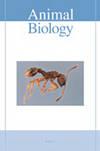Timing of the evening emergence of Hilgendorf’s tube-nosed bat (Murina hilgendorfi) in relation to roost type and season
IF 0.9
4区 生物学
Q2 ZOOLOGY
引用次数: 0
Abstract
Like for many species, the timing of evening emergence of bats is an important behavioral aspect that affects their fitness and has been studied in various bat species. However, little is known about emergence timing of solitary bats that frequently switch day roosts, because they are difficult to observe. In this study, I examined the emergence timing of Hilgendorf’s tube-nosed bats (Murina hilgendorfi), which are solitary and frequently switch roosts, in relation to roost type and season over six years in Hayakawa, central Japan. The results show that the bats emerged after dusk when the light was weak. Later emergence may be related to the habits of this species, such as their solitary lifestyle, slow flight speed, and gleaning foraging strategy, which may enhance predation risk. Individuals roosting in dead foliage and on the outer wall of a building situated in closed forests emerged significantly earlier than those roosting in an old mine and tunnel located in open environments, suggesting that vegetation cover and/or lower predictability of roost location provide security for bats. Bats emerged progressively earlier from late spring (preparturition) to early autumn (late lactation or post-lactation), suggesting that the reproductive status of females or the growth stage of pups may influence emergence timing. To my knowledge, this study provides the first record of the emergence timing of Hilgendorf’s tube-nosed bat, and suggests that predation risk may impact the bats’ emergence behavior.希尔根多夫管鼻蝙蝠(Murina hilgendorfi)傍晚出现的时间与栖息类型和季节的关系
与许多物种一样,蝙蝠夜间出现的时间是影响其健康的一个重要行为方面,已经在各种蝙蝠物种中进行了研究。然而,人们对经常更换日间栖息地的独居蝙蝠的出现时间知之甚少,因为它们很难观察到。在这项研究中,我研究了Hilgendorf管鼻蝙蝠(Murina hilgendorfi)的出现时间,这些蝙蝠是孤独的,经常变换栖息地,与日本中部早川六年来的栖息地类型和季节有关。结果表明,蝙蝠是在黄昏后光线较弱时出现的。后来的出现可能与该物种的习性有关,例如它们孤独的生活方式、缓慢的飞行速度和拾穗觅食策略,这可能会增加捕食风险。栖息在枯叶和封闭森林中建筑物外墙上的个体比栖息在开放环境中的旧矿井和隧道中的个体出现得更早,这表明植被覆盖和/或栖息位置的可预测性较低为蝙蝠提供了安全保障。蝙蝠从晚春(预产期)到初秋(哺乳后期或哺乳后)出现得越来越早,这表明雌性的繁殖状态或幼崽的生长阶段可能会影响出现时间。据我所知,这项研究首次记录了Hilgendorf管鼻蝙蝠的出现时间,并表明捕食风险可能会影响蝙蝠的出现行为。
本文章由计算机程序翻译,如有差异,请以英文原文为准。
求助全文
约1分钟内获得全文
求助全文
来源期刊

Animal Biology
生物-动物学
CiteScore
2.10
自引率
0.00%
发文量
34
审稿时长
3 months
期刊介绍:
Animal Biology publishes high quality papers and focuses on integration of the various disciplines within the broad field of zoology. These disciplines include behaviour, developmental biology, ecology, endocrinology, evolutionary biology, genomics, morphology, neurobiology, physiology, systematics and theoretical biology. Purely descriptive papers will not be considered for publication.
Animal Biology is the official journal of the Royal Dutch Zoological Society since its foundation in 1872. The journal was initially called Archives Néerlandaises de Zoologie, which was changed in 1952 to Netherlands Journal of Zoology, the current name was established in 2003.
 求助内容:
求助内容: 应助结果提醒方式:
应助结果提醒方式:


